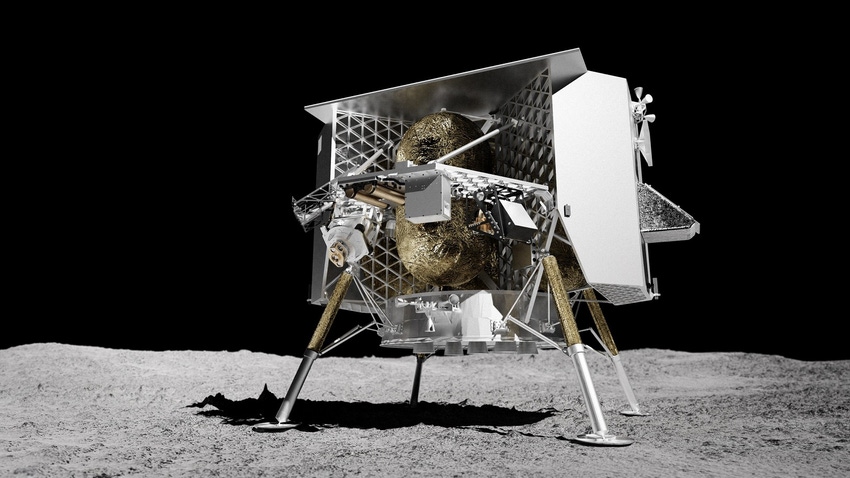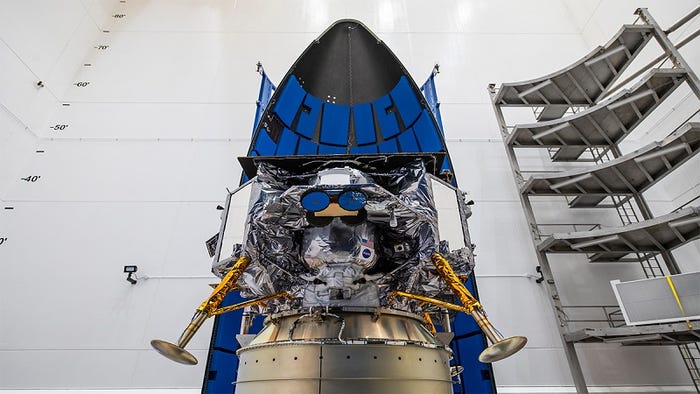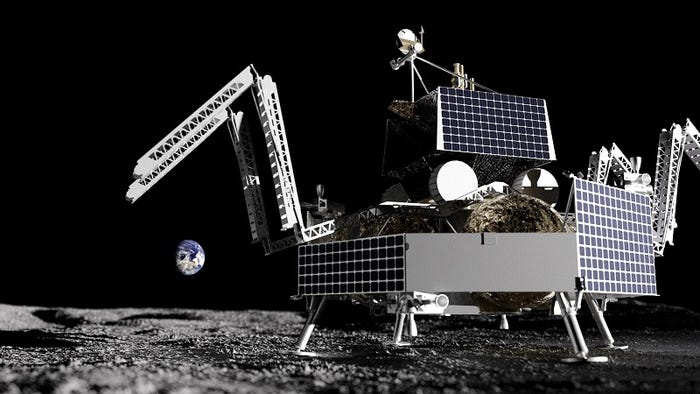The Peregrine Moon Lander Is Ready for Takeoff
Astrobotic’s Peregrine moon lander will take off on a Vulcan rocket in January and land on the moon in February with a payload from six nations.
January 2, 2024

At a Glance
- Heading back to the moon
- The moon lander is ready
The US is ready to land on the moon again. The Peregrine lunar lander has completed all integration milestones and was mated with United Launch Alliance’s Vulcan rocket payload adapter in November. After a three-week campaign to fuel and complete final checkouts, the Peregrine spacecraft is ready to take off for the Moon on January 8, 2024.
The lander launched on the Vulcan rocket and ran into trouble after detaching. Astrobotic Technology is trying to salvage as much of the mission as possible. We'll keep you updated as things develop.

Peregrine in the cleanroom before meeting up with the Vulcan rocket. Image by Astrobotic.
Astrobotic’s Peregrine Mission One is carrying 20 payloads from governments, companies, universities, and NASA’s Commercial Lunar Payload Services. It will be one of the first US lunar landings since the final mission of the Apollo program over 50 years ago.
The payload teams have missions that vary from seeking indications of water-based ice near the lunar surface to demonstrating a rover swarm. The lander also has several payloads representing humanity through artwork and historical artifacts. Here’s a complete list of the Peregrine payload.

Peregrine in the Vulcan rocket. Image by Astrobotic.
The Astrobotic team has been working on this moon landing for many years. “Landing on the Moon’s surface is incredibly difficult. Our team has continuously surpassed expectations and demonstrated incredible ingenuity during flight reviews, spacecraft testing, and major hardware integrations,” John Thornton, Astrobotic’s CEO told Design News. “We are ready for launch, and for landing.”
A Fast and Furious Mission
After launch, Peregrine has a long checklist of milestones to complete on its way to the Moon. The first handful will be executed shortly after launch when the spacecraft will separate from the rocket, power on, and establish communications with Earth. At this stage, telemetry will flow through the NASA Deep Space Network system to the Astrobotic Mission Control Center in Pittsburgh. The data will start informing the mission control team of the spacecraft’s position, orientation, and general operational health.
About 40 minutes after separation from ULA’s Vulcan rocket, Peregrine’s propulsion system will activate and begin receiving commands from Astrobotic’s Mission Control Center. One of the first commands will initiate thrusters to point Peregrine’s solar panels at the Sun to begin charging its battery. During the cruise, the team will orchestrate trajectory adjustment maneuvers in Earth orbit before lunar orbit insertion. Peregrine will then dwell in a stable orbit and perform system checkouts before attempting the landing on February 23, 2024.
“Getting to the moon will take a few days, but the longest is the waiting for is for local sunrise –we have to wait for a lunar day,” said Thronton. “That happens every 28 days. We will operate for 10 days and then the data will be sent back.”

The route of the Peregrine. Image by Astrobotic.
Once it lands, Peregrine payloads will begin sending data back to Earth. “After that, the spacecraft will not be able to survive the cold night and the payload will become a historic landmark. It’s a fast and furious mission since we don’t have the tech on this mission to survive the night.”
Having grown since 2007 from a startup of two to an enterprise employing more than 200 people, Astrobotic’s headquarters includes office space, testing labs, and a mission control center – all essential to the upcoming Peregrine launch, according to Thornton.
More Moon Trips to Come
The Peregrine landing will just be the first for Astrobotic. Later this year, the company is planning to send a larger lander. “At the end of this year, we’ll fly The Griffin to the moon. The Griffin is three to four times the size of the Peregrine,” said Thorton. This will land NASA’s lunar rover. The Griffin will land at one of the moon’s poles where there is more daylight, so it will stay in the sunlight for months.”

Astrobotic's Griffin moon lander. Image by Astrobotic.
Astrobotic is also building CubeRovers, lightweight lunar rovers that can take instruments across the moon’s surface. The company’s operations are part of Pittsburgh’s booming tech and robotics sector which includes more than 140 companies focused on robotics and artificial intelligence.
About the Author(s)
You May Also Like





